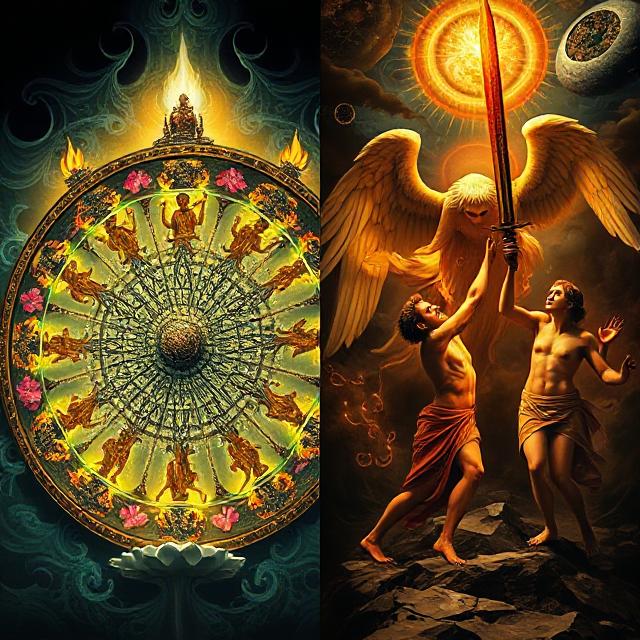
Table of Contents
Samsara vs Original Sin: The Cycle vs The Fall
Few concepts better highlight the divide between Eastern and Western theology than samsara vs original sin. These ancient doctrines underpin the way billions of people understand human suffering, moral failure, and the possibility of redemption. While samsara emphasizes the cyclical nature of existence and the bondage of rebirth, original sin teaches that humanity has fallen from grace and must be redeemed.
This article explores the origin, meaning, and implications of these two powerful ideas, and how they shape the spiritual narratives of Hinduism, Buddhism, and Christianity.
I. What is Samsara?
A. The Cycle of Rebirth
In Hinduism, Buddhism, and Jainism, samsara refers to the cycle of birth, death, and rebirth. It is driven by karma: the moral law of cause and effect.
- Actions in one life influence the conditions of the next.
- The soul (atman) or consciousness is bound by ignorance and desire.
- Rebirth continues until liberation (moksha or nirvana) is attained.
B. The Problem of Attachment
Samsara is not viewed as inherently evil, but it is characterized by suffering (dukkha in Buddhism):
- Impermanence leads to dissatisfaction.
- Attachment to transient things causes bondage.
- Liberation is achieved by extinguishing desire and realizing the illusion of self.
C. Goal: Liberation
Liberation from samsara is a spiritual awakening, not a judicial pardon:
- In Hinduism, moksha involves realizing one’s unity with Brahman.
- In Buddhism, nirvana is the cessation of craving and the end of the self illusion.
- The journey is inward and meditative.
II. What is Original Sin?
A. The Fall from Grace
In Christian theology, original sin refers to the first disobedience of Adam and Eve:
- Eating from the Tree of Knowledge brought death and suffering into the world.
- Their sin was transmitted to all humanity.
- Every person is born with a sinful nature.
“In Adam all die” (1 Corinthians 15:22)
B. The Condition of Guilt
Original sin is not just about actions—it is about a corrupted nature:
- Human will is weakened and prone to evil.
- No one can be righteous through their own efforts.
- The result is separation from God.
C. Goal: Redemption
The solution to original sin is divine grace, not personal effort:
- Christ’s sacrificial death redeems the fallen.
- Salvation is a gift, received by faith.
- The journey is relational and covenantal.
III. Comparing Samsara vs Original Sin
| Feature | Samsara (Eastern) | Original Sin (Western) |
|---|---|---|
| View of Humanity | Spirit trapped in illusion and desire | Fallen from original righteousness |
| Cause of Suffering | Ignorance and craving | Inherited sin nature |
| Path to Freedom | Enlightenment, meditation, detachment | Grace, faith, repentance |
| Role of Deity | Optional (Buddhism), immanent (Hinduism) | Personal, transcendent God |
| Concept of Time | Cyclical, eternal return | Linear, historical fall and redemption |
IV. Psychological and Ethical Implications
A. Samsara: Inner Transformation
The samsaric view emphasizes discipline and mindfulness:
- Every thought and action has consequences across lifetimes.
- Suffering is a teacher, not a punishment.
- Freedom is earned through wisdom and practice.
B. Original Sin: Moral Dependency
The doctrine of original sin underscores human need and divine intervention:
- Sin distorts perception and desire.
- Salvation requires humility and surrender.
- Ethics begins with accepting one’s brokenness.
V. Are They Compatible?
While deeply different, samsara and original sin address the same human questions:
- Why do we suffer?
- Why do we repeat mistakes?
- Is there a way out?
Some theologians and philosophers have attempted interfaith dialogue:
- Christianity has explored Buddhist meditation as a spiritual discipline.
- Buddhists have examined Christ’s compassion as an expression of bodhisattva ideal.
- Some see samsara as addressing the how of suffering, and original sin the why.
Conclusion: Two Narratives, One Longing
Samsara vs original sin are more than dogmas—they are profound attempts to explain the human condition. One sees life as a wheel to be escaped by awakening; the other as a fall to be redeemed by grace.
Together, they reveal our longing to understand pain, our need for transformation, and our search for a home beyond the suffering of this world.
